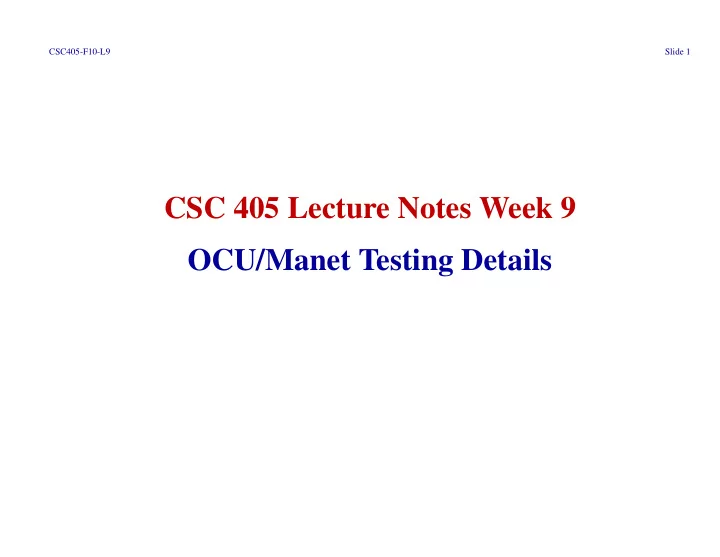

CSC405-F10-L9 Slide 1 CSC 405 Lecture Notes Week 9 OCU/Manet Testing Details
CSC405-F10-L9 Slide 2 I. Revisiting SQLite as a "best practice" example. A. Go over each point in the exec summary. B. Consider if/how these points will be concretely realized in the ocu/manet system.
CSC405-F10-L9 Slide 3 II. Executive Summary • Three independently developed test harnesses • 100% branch test coverage • Millions and millions of test cases
CSC405-F10-L9 Slide 4 Executive Summary, cont’d • Out-of-memory tests • Disabled opt’n tests • I/O error tests • Regression tests • Crash, power loss tests • Malformed DB tests • Fuzz tests • Assert run-time checks • Boundary value tests • Valgrind analysis
CSC405-F10-L9 Slide 5 III. SQLite test harnesses A. Tcl/Tk unit tests. B. Deployed system tests. C. User-level SQL Logic tests.
CSC405-F10-L9 Slide 6 Proposal for OCU/Manet Test Harnesses A. Harness 1: OCU Unplugged. 1. Test with "conventional" CppUnit or Google Test. 2. Alternatively, use larger-grain unit testing framework, akin to Tcl/Tk testing, 3. Driven by loop that programmtically sup- plies inputs to ocu via comm model.
CSC405-F10-L9 Slide 7 OCU/Manet Test Harnesses, cont’d B. Harness 2: Manet Unplugged. 1. Harness 2s: 80211s Unplugged. 2. Harness 2b: Batman Unplugged. 3. Both driven by loops that programmtically supply different network configurations.
CSC405-F10-L9 Slide 8 OCU/Manet Test Harnesses, cont’d C. Harness 3: OCU + Manet integrated. 1. Harness 3s: OCU + 80211s. 2. Harness 3b: OCU + Batman. 3. Driven by manet-unplugged driver.
CSC405-F10-L9 Slide 9 OCU/Manet Test Harnesses, cont’d D. Harness 4: OCU + Manet + Laptops in the Football Field. E. Harness 5: OCU + Manet + Surrogates and Robots in "Live" Environment. F. Harness 6: OCU + Manet + Simulated Robots.
CSC405-F10-L9 Slide 10 IV. 100% branch test coverage A. Use gcov and/or lcov . B. Critically important to ensure coverage of black- box tests. C. SQLite testing handles coverage of defensive code in a novel way
CSC405-F10-L9 Slide 11 V. Millions and millions of test cases A. As a practical matter, these are programmatically generated. B. SQLite has some interesting, potentially reusable strategies.
CSC405-F10-L9 Slide 12 VI. Out-of-memory tests A. Particularly important for C++ code, to test for memory leakage. B. Important in general for all forms of malloc errors. C. Use test-configured versions of malloc.
CSC405-F10-L9 Slide 13 VII. I/O error tests A. In SQLite terms "the system responds sanely to filed I/O operations". B. Can be done with simulated I/O errors.
CSC405-F10-L9 Slide 14 VIII. Crash and power loss tests A. Test that state of OCU is non-corrupted if Manet or its OS crashes. B. Test other deployed-configuration power-loss sce- narios.
CSC405-F10-L9 Slide 15 IX. Fuzz tests A. May want to test for mutation-inducing failures of damaged robots. B. E.g., "fuzzy" behavior that occurs when robot gets partially blown up.
CSC405-F10-L9 Slide 16 X. Boundary value and range tests A. The main driver of test case generation loops. B. Data range parameters currently identified: 1. throughput 2. latency 3. signal strength 4. number of nodes 5. network target node 6. path configuration
CSC405-F10-L9 Slide 17 XI. Disabled optimization tests A. For SQLite testing, this refers to specific forms of query processing. B. For OCU/Manet testing, it can mean that tests need to be run on both -g and -O version of the compiled code.
CSC405-F10-L9 Slide 18 XII. Regression tests A. Of course.
CSC405-F10-L9 Slide 19 XIII. Malformed data tests A. For SQLite, these are tests on various database malformations. B. For OCU/Manet, comparable tests are for various network malformations. C. I’m not entirely clear what external causes there may be of network malformations.
CSC405-F10-L9 Slide 20 XIV. Extensive use of assert() and run-time checks A. In SQLite, the production build disables asserts, for performance. B. I think the same should be true in OCU/Manet.
CSC405-F10-L9 Slide 21 XV. Valgrind analysis A. Valgrind is a Linux simulator that analyzes for a variety of runtime errors. B. If we have a simulated test harness, it might be interesting to run it under valgrind .
CSC405-F10-L9 Slide 22 XVI. Re-visit testing repository structure.
CSC405-F10-L9 Slide 23 XVII. Some practical implementation details. A. Do a sample loop that shows concretely what pro- grammatic driving of ocu/manet could look like. B. Ask Batman and 80211s teams what such a loop would look like for their side of things.
CSC405-F10-L9 Slide 24 XVIII. Action Items for this Week A. Agreed testing framework for OCU teams. B. Agreed testing framework for 80211s teams. C. Committed testing for 80211s and OCU teams. D. Project-wide regression test makefile. E. Agreement, as appro, on preceding practices.
CSC405-F10-L9 Slide 25 XIX. Suggested repository updates. A. Populate testing subirs for all 4 subprojects. B. Move batmobile/implementa- tion/.../*Tests* to batmobile/test- ing/implementation/.../*Tests* . C. Code tests and install for 80211s , kareem- nassar , ocunited .
CSC405-F10-L9 Slide 26 Repository additions and modifications, cont’d D. Add manet-ocu/testing dir, with Make- file for project-wide test build and execute. E. Install bug-tracking supporting infrastructure (if not already there). F. Add requirements dir and put SRS there. G. Add administration dir and put project- wide admin docs there.
CSC405-F10-L9 Slide 27
Recommend
More recommend